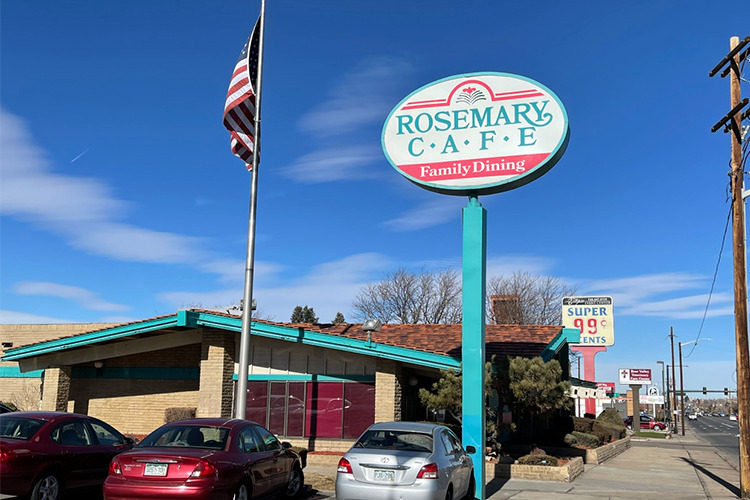
Rosemary’s Cafe, one of the most popular diner’s on Denver’s westside, is being closed down. photo by Mckenzy Perkins
Gentrification has been an issue in the United States since the late 20th century, but how does it affect low income communities in Denver?
The cost of living in major cities across the United States has been rising for the past 15 years, and the biggest factor is gentrification. According to the Denver Post, Denver is the second most gentrified city in the country, with San Francisco being number one. The negative impacts of gentrification have disrupted communities that have lived under the poverty line for decades.
The main force behind gentrification is individuals or corporations buying cheap land and reselling it for a much higher value, making it unaffordable for residents living there. Companies may also take advantage of cheap land and use it to expand their reach. If something is always in high demand, customers are more likely to make the commute. In a business, when supply and demand are high, it is easier to operate. However, supply does not tend to be consistent. So when supply decreases and demand increases, it makes sense to expand the business to new areas. But how companies meet that goal may force out families and local business owners who may have worked their entire lives to get where they were.
Gentrification isn’t just about the rising cost of living but also involves families being displaced from their homes and businesses to build high-rise apartments and corporate-owned businesses in their place. Families living below the poverty line in gentrified areas struggle to make ends meet, and tend to live paycheck to paycheck. In large cities, jobs are in high demand but fill quickly. With experience requirements being high, and with wages not keeping up with the rising costs of basic necessities, it is difficult for workers to maintain a high-paying job. The Colorado Sun Newspaper stated in 2021 that because of rising costs and difficulties in finding jobs, 22.7% of the Colorado population lives without consistent housing or income.
Gentrification in the west side of Denver has been comparable to South Side, Chicago, between the 1980s and 2010s. Over those 30 years, Cabrini Green became one of the few government housing neighborhoods in the South Side area, and in 2011, Cabrini Green was torn down and replaced with high-rise apartments. Gentrification is typically a long and grueling process, but it seems to be hitting Denver much faster and more disastrously.
Most recently, Rosemary’s Cafe in the center of the Harvey Park neighborhood is being bought by the owners of Jelly, one of the newer, more “hip” cafes. It was established in January of 2010 with only one location, but because of its booming business and the demand for more modern eating experiences, the location right next to Denver University became a big hit, establishing a need to open more locations. Rosemary’s Cafe is only one of many diners across Denver owned by Mike Apergis. Apergis also owned Breakfast King, which closed in January of 2022, soon after Denver lifted its mask mandate. More than half of his businesses have been bought and sold for more than their value in the past year. So, when Rosemary’s Cafe closed its doors due to rising property taxes, the owners of Jelly jumped on this opportunity.
The pandemic also significantly influenced the rising cost of living. The average property tax in Denver rose 1.22% from 2021 to 2022. Although that may seem like a small number, even a 1.22% increase in the property tax makes it difficult for low-income families to afford a home in their neighborhood. When property tax increases and corporations build more modern and expensive homes in poorer neighborhoods, it raises the property value of the entire area beyond livable standards.
Buying a home in Denver is an incredibly taxing experience, especially for low-income families after COVID hit. In parts of Denver 10 years ago, such as Harvey Park, Bear Valley, and Sheridan, it was common for low-income families to migrate there due to lower property costs. But since then, property costs have increased exponentially, making it harder to purchase a home anywhere in Denver.
More affluent people moving into low-income neighborhoods combined with higher costs results in a domestic disaster across Denver. People cannot buy homes when they are selling for hundreds of thousands of dollars over the asking price, causing a discrepancy in who can live in the city, a place many call home. When the only people living in normally poor neighborhoods are incredibly wealthy, it upends the community and creates changes that only appease the interests of the new residents.
Gentrification is a pressing issue, and it is possible to stop it. Rather than buying out local businesses, corporations could buy the open lots surrounding the city. Rather than forcing decisions against their will, residents could band together to provide input into the changes happening in their community. Even if they don’t yet understand how to incorporate those changes into their neighborhoods, solutions are available, even if communities feel trapped by the constant ring of gentrification.